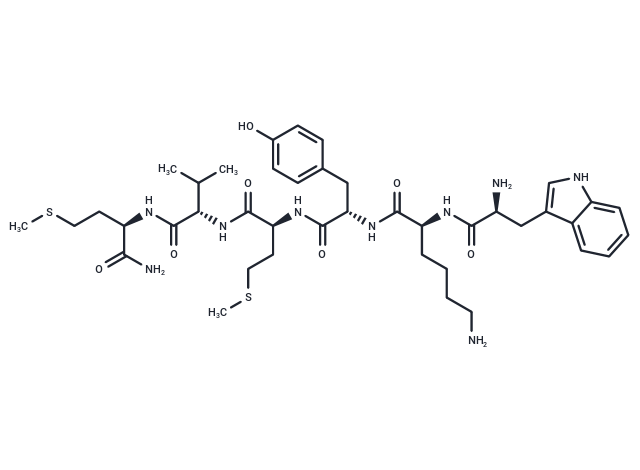Shopping Cart
Remove All Your shopping cart is currently empty
Your shopping cart is currently empty
WKYMVM is a N-formyl peptide receptor (FPR1) agonist.

| Pack Size | Price | USA Warehouse | Global Warehouse | Quantity |
|---|---|---|---|---|
| 1 mg | $716 | 35 days | 35 days |
| Description | WKYMVM is a N-formyl peptide receptor (FPR1) agonist. |
| In vitro | Neutrophils are activated by WKYMVM through FPRL1 and that FPRL2 is a chemotactic receptor transducing signals in myeloid cells[1]. |
| In vivo | Using blood samples withdrawn from 28 AL patients and 31 healthy controls, found that, in the absence of exogenous WKYMVM, WKYMVM receptor and bactericidal activity did not differ between patients and controls.Addition of WKYMVM markedly increased the bactericidal activities of these cells in a dose-dependent manner.During induction chemotherapy, there were significant increases in bactericidal activity in the presence and absence of 1nM WKYMVM, with higher bactericidal activities at the time of complete remission than at the time of diagnosis or on day 15.During consolidation chemotherapy, WKYMVM had no effect on bactericidal activities.Patients showed significant increase in the concentrations of TNF alpha, IL-1b, IL-6 and IL-8, but significant decrease in the concentrations of IL-2, IL-4 and IL-12.TNF alpha, IL-1b and IL-6 showed significant negative correlations with bactericidal activities of patient neutrophils at time of diagnosis, and IL-4 showed a significant positive correlation with bactericidal activities,these findings indicate that WKYMVM enhances bactericidal activity in patients with AL[2]. |
| Cell Research | Ligand-mediated internalization of FPRL1 and FPRL2 was followed by an indirect immunofluorescence microscopy staining technique.?Cells were seeded on polyornithine-coated coverslips 48 h prior to the experiments.?To stop protein synthesis, cells were incubated in RPMI 1640 medium containing 1% BSA and 100 μg/ml cycloheximide for 3 h and maintained in the same medium throughout the experiment.?To study receptor internalization, RINm5F-FPRL1 cells and RINm5F-FPRL2 cells were treated with either WKYMVM or WKYMVm at 37 °C for various time periods ranging from 0 to 30 min. Cells were finally fixed and permeabilized with acetone at ?20 °C for 30 s[1]. |
| Molecular Weight | 856.11 |
| Formula | C41H61N9O7S2 |
| Cas No. | 187986-17-0 |
| Smiles | CSCC[C@@H](NC(=O)[C@@H](NC(=O)[C@H](CCSC)NC(=O)[C@H](Cc1ccc(O)cc1)NC(=O)[C@H](CCCCN)NC(=O)[C@@H](N)Cc1c[nH]c2ccccc12)C(C)C)C(N)=O |
| Relative Density. | 1.268 g/cm3 (Predicted) |
| Sequence | Trp-Lys-Tyr-Met-Val-{d-Met}-NH2 |
| Sequence Short | WKYMV-{d-Met}-NH2 |
| Storage | keep away from moisture | Powder: -20°C for 3 years | In solvent: -80°C for 1 year | Shipping with blue ice/Shipping at ambient temperature. | ||||||||||||||||||||
| Solubility Information | DMSO: 10 mM, Sonication is recommended. | ||||||||||||||||||||
Solution Preparation Table | |||||||||||||||||||||
DMSO
| |||||||||||||||||||||
| Size | Quantity | Unit Price | Amount | Operation |
|---|

Copyright © 2015-2025 TargetMol Chemicals Inc. All Rights Reserved.